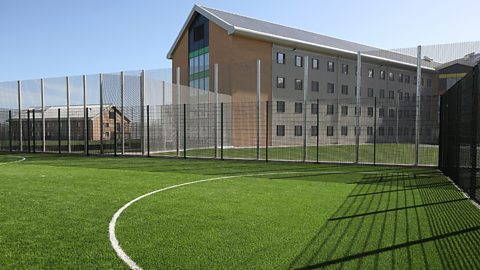Alternative methods of dealing with prisoners in the 20th century
In the 20th century, prisons became the main form of punishment used in Britain. Transportation ended in the 19th century, corporal punishments were used less frequently, with flogging limited in 1914 then finally abolished in 1948, and the death penalty abolished in 1965.
Modern prisons
The harsh regimes in prisons began to change significantly after 1922. Prisoners were allowed to associate with each other, arrow marked uniforms and shaved hair was abolished, and heating, better food and access to education were provided.
Prisoners were given better food, allowed to wear their own clothes and had access to education courses. The aim became to reform and rehabilitate prisoners through education and training. However, as prisons have become more and more overcrowded after 1960, access to training and courses has been more limited.
Prisoners are categorised as either A, B C or D depending on:
- the severity of their crime
- their age
- the level of threat they pose to the public
- their risk of escaping
Prisoners are then sent to a prison for their category.
| Category | Type of prisoner | Type of prison |
| A | Most serious, a significant danger to the public | Traditional closed prison, most secure |
| B | Serious crimes but do not require maximum security | Traditional closed prison |
| C | Not likely to escape but not suited to open prisons | Traditional closed prison |
| D | Low-risk first-time offenders, minor crimes | Open prison |
| Category | A |
|---|---|
| Type of prisoner | Most serious, a significant danger to the public |
| Type of prison | Traditional closed prison, most secure |
| Category | B |
|---|---|
| Type of prisoner | Serious crimes but do not require maximum security |
| Type of prison | Traditional closed prison |
| Category | C |
|---|---|
| Type of prisoner | Not likely to escape but not suited to open prisons |
| Type of prison | Traditional closed prison |
| Category | D |
|---|---|
| Type of prisoner | Low-risk first-time offenders, minor crimes |
| Type of prison | Open prison |
There are no category A prisons in Wales. HMP Belmarsh in London is a category A prison. HMP Cardiff is a category B prison while HMP Swansea is a category B/C prison. HMP Berwyn near Wrexham opened in February 2017 and is a category C prison. It is the largest prison in England and Wales and can hold 2,106 prisoners.

Open prisons
Open prisons were established in 1934 and have more relaxed rules. They are a new method of punishment as they differ so significantly from category A prisons. Prisoners are allowed to leave the prison in the daytime to go to work. Prisoners have keys to their own rooms and there are no large walls or fences.
There is a curfew and prisoners have to return to the prison at night. There are courses and training for inmates. Many open prisons have their own farms or workshops to train inmates for careers. They became popular due to the overcrowding of prisons following the Second World War. Their focus is on resettling prisoners into the community as a way of preventing reoffending.
Many inmates in an open prison are low-risk first time offenders who have committed minor crimes. Others are transferred from higher category prisons near the end of their sentence to prepare for life back in the community.
Open prisons have had bad publicity in recent years after some scandals about the amount of alcohol and drugs that prisoners have access to. HMP Prescoed near Usk is a category D open prison.
20th century women prisoners
Holloway prison in London became a female-only prison in 1903, and was the largest female prison in Western Europe until its closure in 2016.
Family liaison is held as a priority but the geographical spread of women’s prisons can make maintaining family links difficult. There are no women’s prisons in Wales.
Young offenders
Borstals were introduced as an alternative to prison for young offenders, and the first one opened in Kent in 1902. Boys aged between 15 and 21 years old were imprisoned here. They were designed to educate and reform young offenders, so inmates had access to education and training courses. There were strict rules in borstals, and until 1962, boys in borstals were whipped. Borstals were abolished in 1982.
Around 60 per cent of those released from borstals went on to reoffend, so the Government introduced Youth Detention Centres, which were intended to provide youths with a 'short, sharp, shock'. However, this tougher stance also failed to impact on reoffending as the rates actually increased.
In 1988, Young Offenders Institutions were set up. These were for offenders aged between 18 and 21 years old. Inmates have 25 hours a week of education. These are considered a last resort after probation and non-custodial sentences have failed, and those that are remanded in such places still have the highest rates of reoffending.
Young offenders can also be sent to secure training centres, secure children’s homes or juvenile prisons.
HMP Parc in Bridgend is the only facility in Wales for youth detentions and is a male-only prison. There are no Young Offenders Institutions in Wales.